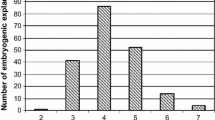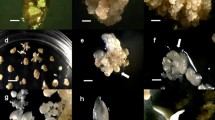Summary
An efficient culture system has been developed for repeated cycles of somatic embryogenesis in microspore-derived embryos of Brassica juncea without a callus phase. Haploid embryos produced through anther culture showed a high propensity for direct production of somatic embryos in response to 2 mgL−1 BA and 0.1 mgL−1 NAA. The embryogenic cultures which comprised the elongated embryonal axis of microspore-derived embryos when explanted and grown on the medium of same composition produced a large number of secondary embryos. These somatic embryos in turn underwent axis elongation and produced more somatic embryos when explanted and cultured. This cycle of repetitive somatic embryogenesis continued with undiminished vigour passage after passage and was monitored for more than a year. Somatic embryos from any passage when isolated at cotyledonary stage and grown on auxin-free medium for 5 days and then on a medium containing NAA (0.1 mgL−1), developed into complete plants with a profuse root system and were easily established in the soil. The cytology of the root tips of these plants confirmed their haploid nature. The total absence of callus phase makes the system ideal for continuous cloning of androgenic lines, Agrobacterium-mediated transformation and mutation induction studies.
Similar content being viewed by others
References
Geier T, Kohlenbach HW (1973) Protplasma 78: 381
George EF, Sherrington PD (1984) In: Handbook and Directory of Commercial Laboratories, Exegetics Limited, England, pp 160–166
George L, Rao PS (1982) Plant Sci Lett 26: 111–116.
Keller WA, Armstrong KC (1977) Can Jour Bot 55: 1383–1388.
Keller WA, Rajhathy T, Lacapra J (1975) Can Jour Genet Cyt 17: 655–666.
Loh CS, Ingram DS (1982) New Phytol 91: 507–516.
Loh CS, Ingram DS, Henke DE (1983) New Phytol 95: 349–358
Maheswaran G, Williams EG (1984) Ann Bot 54: 201–211.
Parrott WA, Williams EG, Hildebrandt DF, Collins GB (1988) IAPTC Newsletter No. 54 pp 10–19
Rajasekaran K, Mullins MG (1979) Jour Exp Bot 30: 399–407
Rashid A (1988) In: Cell Physiology and Genetics of Higher Plants. CRC Press, Florida. Vol I, pp 119–158
Sacristan MD (1982) Theor Appl Genet 61: 193–200
Sacristan MD, Hoffmann F (1979) Theor Appl Genet 54: 129–132
Sharma KK, Bhojwani SS (1985) Plant Cell Tiss Org Cult 4: 235–239.
Sharp WR, Evans M, Sondahl R (1982) In: Fujiwara A (ed) Plant Tissue Culture, Tokyo, pp 759–762.
Thomas E, Hoffmann F, Potrykus I, Wenzel G (1976) Mol Gen Genet 145: 245–247
Vasil IJ, Lu CY, Ozias-Akins P, Haydu A, Wang DY (1982) In: Earle ED, Damarly Y (eds) Variability in Plants Regenerated from Tissue Culture, Praeger Publishers, New York, pp 3–21
Wenzel G, Hoffmann F, Thomas E (1977) Zeit Pflanzenzuch 78: 149–155
Author information
Authors and Affiliations
Additional information
Communicated by I. K. Vasil
Rights and permissions
About this article
Cite this article
Prabhudesai, V., Bhaskaran, S. A continuous culture system of direct somatic embryogenesis in microspore-derived embryos of Brassica juncea . Plant Cell Reports 12, 289–292 (1993). https://doi.org/10.1007/BF00237138
Received:
Revised:
Issue Date:
DOI: https://doi.org/10.1007/BF00237138




